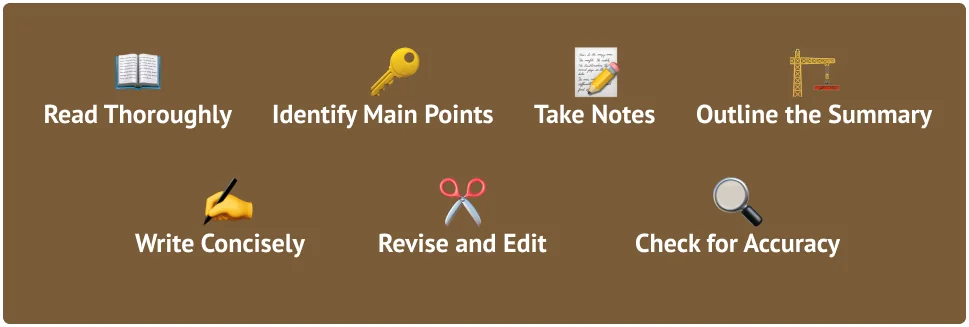Summarizing a story involves squeezing it into a brief exposition that highlights its main points and overall narrative without losing its core essence. When you condense a story into a summary, shrinking the text isn’t your main goal. Clarifying its essence is the purpose of summaries.

✅ AI Essay Writer ✅ AI Detector ✅ Plagchecker ✅ Paraphraser
✅ Summarizer ✅ Citation Generator
What is a Summary of a Story?
A summary strips a story down to its core components, primarily focusing on the major events and central characters. It gives the audience a clear view of the story’s framework without the ornamentation of minor details.

This skill is useful in a variety of situations. In education, it enables students to improve their capacity to recognize and communicate the major ideas of their readings. Having an ability to synthesize information effectively is useful in many professional fields, including journalism, business, and technology. It promotes quick decision-making and effective communication. Furthermore, it is a social asset for stimulating discussions on media or literature.
Structural Elements of a Summary
A well-written summary is a shortened version of a story that captures the essential elements of a narrative in a clear and brief format. Understanding and applying the right structural elements is essential in planning an effective summary. Here’s a look at these elements:
📏 Brevity: Keep it Short
A summary should be succinct, filtering a story to its fundamental elements without oversimplification. The goal is to reduce the original content to its core, focusing only on major events and key characters. This means skipping most descriptive details, subplots, and secondary characters unless they are critical to the story’s outcome. Brevity also involves being mindful of word choice, opting for potent yet compact expressions that convey more with less.
🌟 Clarity: Crystal Clear
Your summary should provide a clear and accurate representation of the story. This includes a straightforward account of the plot and its major components without ambiguity. Use direct language and simple sentence structures to enhance understanding. Clarity helps the reader get the story’s plot and the intentions of its characters without any confusion, which is especially important when complex themes and motifs are at play.
🔍 Focus: Main Points Only
Focus on the essential elements of the story, such as the conflict, the pivotal events, and the character turns that drive the plot forward. A focused summary does not wander into detailed descriptions or secondary thematic elements. Instead, it hones in on what is truly important for understanding the overall story.
📖 Objectivity: Just the Facts
A summary should be objective, presenting the story without personal bias or interpretation. This means writing in the third person and avoiding subjective commentary. The use of objective language helps maintain the author’s original tone and preserves the integrity of the story. This is necessary for educational and professional purposes, where the summary is used to present factual information rather than personal opinions.
⏳ Chronological Order: Keep the Timeline
Maintain the sequence of events as they unfold in the story. A summary should not rearrange the plot but should present it in a linear progression from the beginning to the middle and, finally, the conclusion. This helps in preserving the logical flow and makes it easier for the reader to follow and understand the progression of the plot. Even when summarizing complex stories that may feature flashbacks or non-linear timelines, try to convey this in a logical and easy-to-follow manner.
How to Summarise a Story?
Creating a high-quality summary, like any other piece of writing, demands well-organized planning and a defined technique of implementation. It is vital to understand the necessary steps to guarantee that, in the quest for brevity, the primary message of the work is not lost.
When struggling to summarize the story, consider giving the AHelp story summarizer a chance. This tool will provide a brief overview of the story and help you better understand the concept of reviewing.

Read Thoroughly: Understand the Full Picture
Before attempting to summarize, read the entire story attentively to get all aspects of the narrative. This understanding is critical for capturing every significant detail, from the development of the plot to the evolution of the characters. Pay special attention to how the story unfolds, the turning points, and the resolution. This step sets the foundation for a robust summary.
Identify Main Points: Extract Key Elements
Once you’ve read the story, the next step is to filter through the details and identify the key elements. Focus on the main conflict, the central characters, and the pivotal events that drive the story forward. Recognize themes and the author’s message as these often frame the stoty. Highlight these elements as they will form the backbone of your summary.
Take Notes: Bullet Important Details
As you identify the main points, write them down in bullet points or a structured outline. This will help you organize your thoughts and you won’t miss any crucial information during the summarization process. Note-taking is particularly useful for complex stories with multiple characters and intertwined plots as it helps keep track of the narrative flow.
Outline the Summary: Structure Your Content
Use your notes to create a detailed outline for your summary. This outline should reflect the chronological order of the story, focusing on how the narrative progresses from the introduction to the climax and then the resolution. Arrange the identified key elements logically and make sure they connect coherently to present the story succinctly.
Write Concisely: Be Clear and Direct
With your outline as a guide, start writing the summary. Use clear and direct language to convey the story’s key points. Avoid verbosity. The goal is to be as laconic as possible while keeping the summary comprehensive and complete. Make sure to keep your writing neutral and factual, avoiding the inclusion of personal opinions or interpretations.
Revise and Edit: Refine Your Summary
The first draft of your summary is rarely perfect. Read through your summary to see if it is clear and concise. Check for any grammatical errors or awkward phrasing and refine the language for clarity and flow. Ensure that your summary accurately reflects the story’s main points and is understandable even to someone who hasn’t read the original text.
Check for Accuracy: Ensure Faithful Representation
Finally, compare your summary with the original story to double-check you have not omitted essential information or misrepresented the plot or characters. This step is crucial for maintaining the integrity of the original narrative and ensuring that the summary is a true reflection of the story.
FAQ
Follow us on Reddit for more insights and updates.





Comments (0)
Welcome to A*Help comments!
We’re all about debate and discussion at A*Help.
We value the diverse opinions of users, so you may find points of view that you don’t agree with. And that’s cool. However, there are certain things we’re not OK with: attempts to manipulate our data in any way, for example, or the posting of discriminative, offensive, hateful, or disparaging material.